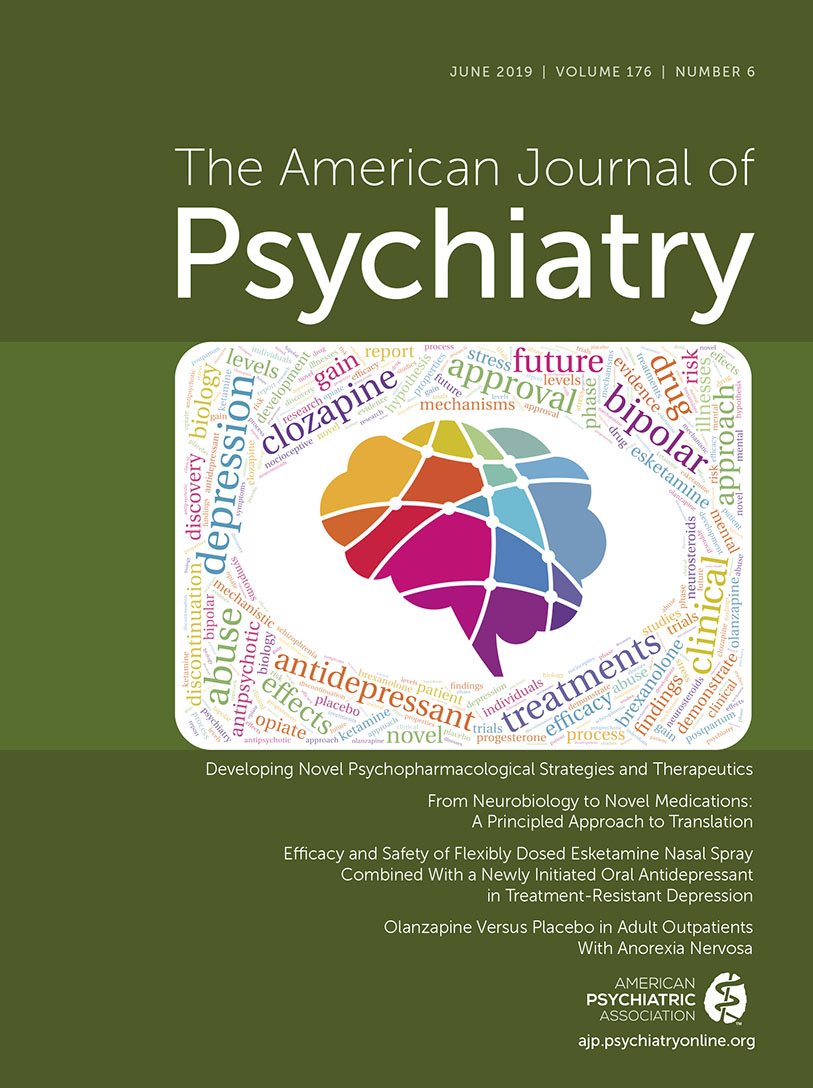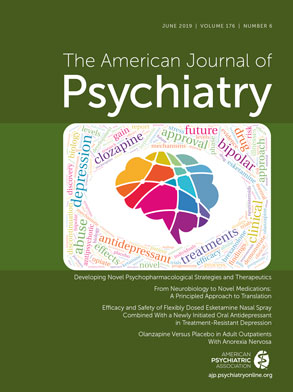Rarely has there been so much anticipation for a new antidepressant as has been seen for intranasal esketamine, the putatively more effective enantiomer of ketamine. This reflects the exposure given to studies on the off-label intravenous use of racemic mixture ketamine for refractory depression and its ensuing availability via ketamine clinics and infusion centers. Intranasal esketamine represents a novel way of administering the agent and is the subject of the report in this issue by Popova et al. (
1).
This pivotal phase 3 study demonstrated rapid separation (by 24–48 hours) for esketamine plus antidepressant compared with placebo plus antidepressant, with continued separation with repeated administration up to 28 days. Esketamine was administered twice weekly for 4 weeks. This trial was presented as part of the recent approval of esketamine by the U.S. Food and Drug Administration (FDA) for refractory depression. During that process, a number of worrisome findings were revealed that should give potential users some pause and call for a concise framework for assessing the risk-benefit balance for using this formulation of ketamine.
The phase 3 program included three pivotal trials, and in only the Popova et al. study was there a statistically significant separation from placebo on the primary endpoint. In the other two trials, mean differences in change scores were similar to those in this report but did not attain statistical significance. The effect size in the Popova et al. study was 0.30, that is, in the mild range. With the use of saline as a control for esketamine, the reader should have cause to wonder, with a small effect and a rather limited control comparison, whether efficacy has been truly demonstrated. The control condition produced little in the way of side effects similar to those of esketamine, although some individuals seemed to experience dissociation with placebo. Moreover, as demonstrated in Figure 1 in the article, the difference was seen early and was maintained throughout the trial, but there was no further gain in advantage beyond the initial separation.
The study design in this development program called for an antidepressant to be started at the same time as esketamine or placebo. Since the patients were treated with the combination of an active antidepressant plus either esketamine or placebo, the data make one wonder whether one really needs to continue esketamine beyond initial use. Why not use it only once or twice for 1 or 2 weeks rather than twice weekly for 4 weeks? This question needs to be considered in the context of what ketamine is—an anesthetic agent that has been abused in this country and elsewhere in various formulations. A recent report on a rodent study points out that continued use of ketamine maintains and extends its acute neuronal spine–producing effects to produce stronger interneuron communication, suggesting that some continued use is necessary to maintain biological effects (
2). But how much and for how long in humans? The package insert for the drug in refractory depression currently recommends twice-weekly administration for 4 weeks, once weekly for 4 weeks, and then, beyond 8 weeks, once weekly or once every 2 weeks, aiming for the least frequent dosing to maintain response or remission.
Our group has reported in this journal (
3) that the acute antidepressant effects of ketamine are blocked when the patient is pretreated with oral naltrexone, indicating that ketamine’s antidepressant effects are mediated by mu opioid agonism. We could not determine whether the effect was a release of endogenous opioids or some binding to the mu opioid receptor. Also, our results did not rule out that NMDA antagonism may be needed for maintaining the response (
3). The opioid properties may explain the drug’s abusability and raise concerns regarding liability with longer-term use.
The drug’s opioid properties need to be considered when considering how best to use it. A release of endogenous opioids by ketamine has been reported by Pacheco et al. (
4) in a rodent pain study where antinociception was blocked by the mu opioid receptor antagonist naloxone, and this mechanism may be unique for ketamine. At first glance, that release would suggest a risk of developing tachyphylaxis and risk of withdrawal symptoms. But ketamine has been reported to reduce the risk of tolerance with opioids (
5) and, at anesthetic doses, to reduce postsurgery opioid use, likely through its NMDA antagonism effects (
6). Thus, this unique pharmacology may not be a problem with “continued intermittent” use. Indeed, it was recently reported that endogenous and synthetic opioids behave differently at the Golgi membrane levels (
7), and that may explain differences in risk. At any rate, further studies, both in animals and humans, are needed to understand the opioid effects of ketamine.
Reasons for concern, however, rest with the known abusability of ketamine in humans, and these issues were raised in an earlier commentary on ketamine in this journal (
8). They are reinforced by the data in the FDA’s Briefing Document (
9), in which the manufacturer reported on a drug relapse prevention/discontinuation study where patients were treated with ketamine plus antidepressant for 16 weeks and then tapered to once per week to once per 2 weeks before being randomized to continuing treatment with antidepressant plus ketamine or antidepressant plus placebo. The study was used as a second positive trial to support proof of efficacy, which, as previously noted (
8), is a somewhat unusual application in proof of efficacy. Patients assigned to placebo showed significantly greater relapse rates by 2 weeks, which is a much shorter time frame than other discontinuation studies with known antidepressants where patients are actually taken off all drugs and differences in relapse are observed by 1 month or more (
8). Relapse rates on discontinuing esketamine reached 40% by 3–4 months even though patients were receiving known antidepressants. This raises the question as to whether patients should be receiving esketamine for even longer periods—or would that be even more risky? What is more worrisome than this rapid relapse coming off even less frequent esketamine administration were the three suicides that occurred 4–20 days after the last dose of esketamine (there were none in the placebo group). Two of the patients who died by suicide showed no previous signs of suicidal activity during the study, either at baseline or at the last visit. This suggests a protracted withdrawal reaction, as has been reported with opioids, and one that is different from the more physical withdrawal symptoms seen acutely with opioids (
10).
Given the rapid relapse and potential suicide risk, it is hard to know what to recommend to clinicians. Should they really continue to use the agent beyond an acute course? For how long? In whom? Unfortunately, the long-term discontinuation study that demonstrates efficacy may not be the best paradigm for a drug of abuse where coming off the drug may be more important and informative than the period when taking it. The FDA Briefing Document (
9, p. 42) states, in regard to the suicides, that “given the small number of cases, the severity of the patients’ underlying illness, and the lack of a consistent pattern among these cases, it is difficult to consider these deaths as drug-related.” This appears misguided. Discontinuation reactions can certainly be due to the drug even though patients are not taking them at that time. Unfortunately, when one approaches ketamine as another antidepressant rather than a drug of abuse, this type of trap is easy to fall into, and in the end, such mistakes can be catastrophic. We have witnessed four decades of supposedly new and safer opioids that have turned out often to be, if anything, even more abusable and lethal. The FDA has asked the company to track patients for 3 years, and these data should help. In addition, the restricted distribution limits patients’ access to the drug to approved medical settings, with patients observed for side effects for 2 hours.
So, where are we? Intranasal esketamine represents an easier method of administration than intravenous administration of ketamine. Do we have clear evidence of efficacy? Maybe? How strong is the efficacy? Apparently mild. Do we have a real sense of how long and how often to prescribe it? It’s not entirely clear. If patients lose response, should we increase the frequency of administration? This could be problematic. Can coming off the drug be problematic? Data suggest that it could be an issue. Taken together, there are more questions than answers with intranasal esketamine, and care should be exercised in its application in clinical practice. Only time will tell how useful it will be. Still, the agent could be helpful to many patients with refractory depression, and efforts to develop rapidly acting agents for severely depressed patients need to be applauded.

